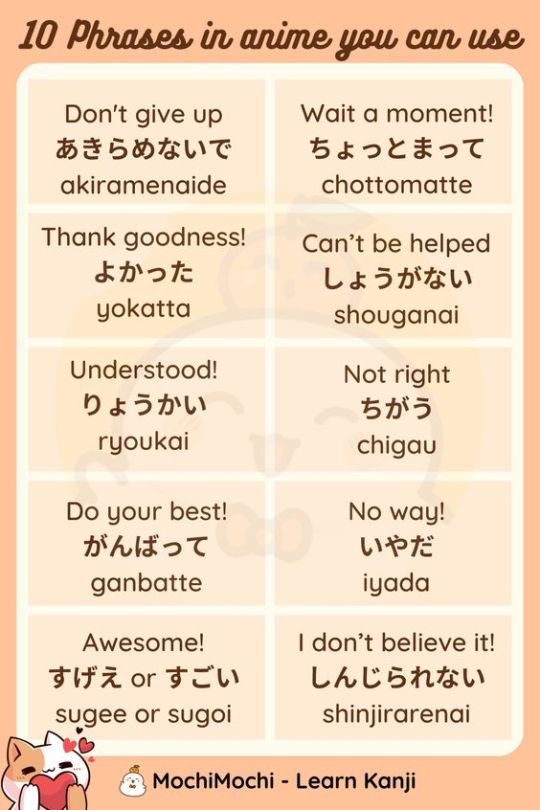#learnJapanese
Explore tagged Tumblr posts
Text
JLPT N5 - あげる
At its simplest, あげる means “to give”. At the N5 level, it’s used for giving physical things such as presents, money, water (to plants), food (to pets), etc. There is another way it can be used, but that is for a later JLPT level. For now, let’s get into ONE of the ways you can talk about giving in Japanese.
First, here is the vocabulary for this post.

【The Grammar of あげる】
Basically there are 4 parts to every あげる sentence that you should be thinking about. The first 3 are marked with particles and the last part is the verb.

Here is an example sentence:
① 【けんじは】【トムに】【腕時計を】あげた。
= As for Kenji, to Tom, a watch gave
= Kenji gave Tom a watch.
In a sentence like #1 it’s easy to see the 3 parts clearly marked with particles and then the verb at the end. Unfortunately you WILL NOT always see simple sentences like this, so let’s look at each part one by one, along with the cultural context behind あげる.
【The Giver】
Most of the time, the giver will be marked by the は (or sometimes the が) particle. This is because あげる sets up the action of giving from the giver’s perspective.
Sometimes, it is obvious who the giver is, so that phrase can be completely left out of the sentence.
② 【会社の人たちに】【お土産を】あげると思う。
= to the people at (my) company, souvenirs will give I think
= I think I’m going to give the people at my company souvenirs.
In this sentence it would be clear that the speaker is the giver. Therefore it’s not necessary to include a 私は phrase.
【The Relationship Between Giver and Receiver】
Before we move on, let’s get into a very big cultural difference between Japan and English-speaking cultures. When you use あげる, you have to think about the relationship between the giver and the receiver. In English, this doesn’t affect the words we use, but in Japanese it is actually very important when it comes to word choice. Take a look at this image:

The green circle would include close friends, family, your lover, etc. Pets and plants would also fall into this circle. Outside of the green circle are strangers, teachers, professors and depending on your job, your customers. This is because showing respect is directly connected to setting up a kind of psychological distance. You have to work hard and gain trust before you are moved into the green circle.
Some people, like coworkers and bosses, may be inside the green circle in some situations, but outside of it in other situations! A common example is when you go out drinking with coworkers. As the alcohol flows throughout the night you’ll notice that psychological space slowly disappearing - that is until the next day at work. They might act like the person you drank with was a COMPLETELY different person!
This way of thinking is called うちそと, and can be a very difficult part of Japanese culture for many foreigners. Here’s the thing: the culture of うちそと extends to the concept of giving as well.
【Giving Culture and あげる】
When it comes to giving, there are 4 situations where it’s appropriate to use the verb あげる:
① When you give something to someone inside your inner circle
② When you give something to anyone outside your inner circle
③ When someone in your inner circle gives something to someone outside your inner circle
④ When someone outside your inner circle gives something to another person outside your inner circle
Numbers 1-3 can be described as the act of giving while moving from a smaller circle to a bigger circle. Number 4 can be described as giving that doesn’t happen in your inner circle.

There are of course more possibilities when it comes to giving (and receiving). However, those situations won’t use the verb あげる!
【What Is Being Given】
In most sentences, whatever is being given is very simply marked with the を particle. However, there are times when the を particle or the positioning of what is being given will change. Take a look at these three example sentences:

Example 3a is the “default version”. The doll is marked with the を particle so we immediately know that it will be given to someone (the section manager’s wife).
For example 3b I want you to imagine that you are in a souvenir shop. You’ve bought a couple of things already, but you haven‘t decided which gifts will go to whom. All of a sudden, you see a doll that catches your eye. You immediately think to yourself, “that doll is perfect for the section manager’s wife”. Putting the item being given (that is, the doll) at the head of the sentence shows that 1) you are putting the focus of your sentence on that item and 2) there is a kind of impulsiveness to the giving. It’s kind of an instant decision.
Compare that with example 3c. Now I want you to imagine that you are in your house. You bought a bunch of dolls but you haven’t decided which one will go to whom. You pick up one of them and after some thought you say, “Ok I’ll give THIS one to the section manager’s wife.” Marking the doll with は serves to emphasize that there are several dolls, but you are highlighting one of them for a specific reason. It also shows that it WAS NOT an instant decision; some thought went into your decision.
This kind of distinction takes a really long time to understand and really “feel” but I hope that by explaining it to you now, it might stay with you somewhere deep inside your mind. You might even experiment with using sentences like 3b and 3c and surprise your Japanese friends!
【Alternative Verbs】
Lastly, let’s talk about your choice of verbs. You can actually adjust the level of “closeness” that the reader / listener feels by changing the verb that you use! あげる, あげた, あげます, あげました, etc. is used for a “default” level of closeness.
However, if the receiver is someone in a higher social position (for example a professor, a doctor, a boss, a politician, etc.) you would instead use the similar verb さしあげる. This verb actually serves to humble yourself - and thus elevates the listener / reader.
④ 【この本は】ただでさしあげます。
= as for this book, for nothing will give
= I will give you this book for free.
From this sentence you can tell that the giver and the receiver are on different levels, socially. (This is a little different than うちそと.) The listener will feel an elevated level respect simply by hearing the さしあげる verb.
On the other hand, if the receiver is someone VERY close to you, you can show that closeness by using the verb やる instead of あげる. やる is often used with pets and plants.
⑤ 【彼女は】【犬に】【えさを】やるのを忘れた。
= as for her, to (her) dog food giving forgot
= She forgot to give her dog food.
As it turns out, this is why I keep on saying “what is given” instead of “a present” or “a gift”. Giving water to plants or food to pets is not a present or a gift.
Here is a visual representation of the 3 different verbs that you can use when talking about giving (from the giver’s perspective):

Here is 1 last example:

= as for apples I give to you, there are none
= I don’t have any apples to give you.
As you can see in #6, it’s possible to state a giver, a receiver and then あげる in order to describe what is being given. Once you do that, you will then have a topic which you can then go on to make a comment about!
【Conclusion】
So there you have it! あげる and its related verbs (さしあげる and やる) all express the idea of giving from the giver’s perspective. However, you have to keep the Japanese concept of うちそと in mind. Later we’ll talk about giving but from the receiver’s perspective. Stay tuned!
Rice & Peace!
-AL (アル)
👋🏾
#日本語#japanese studyblr#japanese grammar#japanese language#isshonihongo#japanese culture#あげる#jlptn5#jlpt#japanese#learn japanese#japanese lesson#japanese study#studying japanese#japaneselessons#learnjapanese#japanese langblr#japanese vocab#japanese vocabulary#language#languages#language study#language studyblr#language blr#日本語の勉強#にほんご
157 notes
·
View notes
Text
Two-kanji compounds using only elementary first-grade kanji




64 notes
·
View notes
Text
🌲🏕️🌳ᕕ( ᐛ )ᕗ🌳🐅🌲 It's always good to know exactly where you're going. And, these particles will help you get where you're going on your Japanese language learning journey! -📚 ー 📝𝐉𝐚𝐩𝐚𝐧𝐞𝐬𝐞 𝐏𝐚𝐫𝐭𝐢𝐜𝐥𝐞𝐬 に+へ(𝚒𝚗𝚝𝚛𝚘)
-💬ー (๑・ω・๑)[・▿・](๑・ω・๑) Particles に and へ may seem too similar to differentiate at first, but with some explanation and examples, you'll be on your way to Japanese sentence creating success!
27 notes
·
View notes
Text

And with that, the end of Vanitas no Carte volume 2.
I have accidentally maintained the bad habit of being scared of immersion because it used to be so hard.
The first year or so is like being lost at sea, before all the pieces (grammar, kanji, meaning) start to come together.
Eventually it just kind of all makes sense (3 years or so).
I can’t believe I can actually read manga fluidly now.
#learnjapanese#self study#vanitas no carte#jun mochizuki#immersion#the case study of vanitas#language learning#studyblr
10 notes
·
View notes
Text

Let's break the ice with these conversation starters in Japanese. 🇯🇵 Perfect for impressing your friends or making new ones! 👋
#mondly#languages#languagelearning#learnlanguages#japanese#learnjapanese#japaneselesson#didyouknow#japaneseforbeginners#japaneselanguage#japaneseteacher#japaneseclass#japaneselearning#japaneseonline#nihongo
10 notes
·
View notes
Text


Late night studies, featuring my notes. 😌 These were taken back in May when I was still doing an online Japanese language course.
#study japanese#study motivation#study notes#studyinspo#studyblr#study blog#learn japanese#langblr#learnjapanese#japanese studyblr#japanese studyspo
52 notes
·
View notes
Text

Hi little blog, it’s me I’m back from the dead I’m 26 and married now oh and I’ve spent the last 2 years learning Japanese, so I can read this now 😊 🎩 🫖
#ifonlybreakwasbackfromthedeadtoo#pandora hearts#pandorahearts#xerxes break#ph spoliers#spoliers#language learning#learnjapanese#manga
13 notes
·
View notes
Text
instagram
🍁Don’t let today’s Japanese vocab fall away! 🍂Learn with us at:

🖥🖱Visit us at ieindigoeast.com to not only hear 𝗝𝗮𝗽𝗮𝗻𝗲𝘀𝗲 𝗽𝗿𝗼𝗻𝘂𝗻𝗰𝗶𝗮𝘁𝗶𝗼𝗻𝘀 & 𝗲𝘅𝗮𝗺𝗽𝗹𝗲 𝘀𝗲𝗻𝘁𝗲𝗻𝗰𝗲𝘀 for multiple level, but also learn today’s vocabulary word’s usage, alternate readings, kanji details, and more! 💥Also, enjoy newly added politeness and difficulty ratings for each example sentence! ・ 👋(・ω・)[ ・▿・ ]👋 (・ω・) ❤/💬/🔖/✉️ありがとう!! ・ 💡𝘾𝙖𝙣 𝙮𝙤𝙪 𝙜𝙪𝙚𝙨𝙨 𝙩𝙤𝙙𝙖𝙮’𝙨 𝙨𝙚𝙘𝙧𝙚𝙩 𝙘𝙤𝙙𝙚? You’ll find the answer at the end of today’s lesson! ・ 📚Access the WotWw/Q archives by visiting ieindigoeast.com and selecting the 𝐖𝐨𝐫𝐝 𝐨𝐟 𝐭𝐡𝐞 𝐖𝐞𝐞𝐤 𝐰/ 𝐐𝐔𝐈𝐙𝐁𝐎™ banner.
#learnjapanese#japanese#japaneseteacher#languagestudy#learningjapanese#studyjapanese#日本語勉強#日本語#日本#にほんご#nihongo#animation#wordoftheweek#quizbo#kiki#koko#jlpt#japanesevocabulary#vocabulary#vocab#単語#言葉#言語#japanesestudygram#studyingjapanese#日本語教師#japaneselanguage#languageblog#library#図書館
3 notes
·
View notes
Text
Useful Anime Phrases | Learn Basic Japanese Phrases
Are you a big fan of anime? Many foreigners are drawn to Japan in part because of their love of anime. Impress your friends with these most popular Japanese expressions in anime below.

7 notes
·
View notes
Text
The Ultimate Guide to Staying Motivated When Learning Japanese
What are some tips for staying motivated when learning Japanese?
Here are some tips for staying motivated when learning Japanese:
Set realistic goals. Don't try to learn too much too soon, or you'll get discouraged. Set small, achievable goals for yourself, and celebrate your successes along the way.
Find a learning method that works for you. There are many different ways to learn Japanese, so find a method that you enjoy and that fits your learning style. There are many free resources available online, as well as apps, textbooks, and even in-person classes.
Make it fun! Learning a new language should be enjoyable, so find ways to make it fun for yourself. Watch Japanese movies and TV shows, listen to Japanese music, or read Japanese books or manga.
Immerse yourself in the language. The best way to learn a language is to immerse yourself in it as much as possible. This means surrounding yourself with Japanese language and culture. You can do this by watching Japanese TV shows and movies, listening to Japanese music, reading Japanese books and manga, or even traveling to Japan.
Have a reason for learning Japanese. What is your motivation for learning Japanese? Do you want to travel to Japan? Watch Japanese anime or movies without subtitles? Talk to Japanese friends or family? Having a clear goal in mind will help you stay motivated when things get tough.
Don't be afraid to make mistakes. Everyone makes mistakes when they're learning a new language. It's important to not let this discourage you. Instead, view mistakes as an opportunity to learn and improve.
Find a language partner. Learning with a language partner is a great way to stay motivated and to practice your Japanese speaking skills. You can find language partners online or through local Japanese language schools or meetups.
Reward yourself. When you reach a learning goal, reward yourself with something you enjoy. This will help you stay motivated and to keep working towards your goals.
I hope these tips help you stay motivated when learning Japanese. Learn more about the Japanese language here! Tokyo International Education Institute

#study abroad#language#language courses#study in japan#learnjapanese#japaneselanguage#japaneselearning
8 notes
·
View notes
Text
JLPT N5 - している [Part 2]
Hey everyone, welcome to Part 2 of talking about している. This N5 grammar point is very basic but also very important. Let’s get into it shall we!
But first, here is your vocabulary:

【English Helping Verbs】
As I mentioned in Part 1, the “して“ in している can stand for any verb in て form. Sometimes it is actually する, but most times it will be some other verb.
Ok great, but what is the いる part?? Take a look at the following English sentences:
① Traffic accidents often occur here.
② I am eating.
③ The window is open.
Two of these sentences have both a helping verb and a main verb. In #1, there is only a main verb, which is “occur”. In #2 the main verb is “eating” and the helping verb is “am”. In #3 the main verb is “open” and the helping verb is “is”. Notice that one of the main verbs has the -ing suffix while the other two don’t. Make a mental note of this for later. 😉
【The いる in している】
Japanese also has helping verbs. Allow me to introduce you to one of the most common ones: いる!
The いる helping verb* adds nuance to the main verb. But here’s the thing - there are different versions of いる!In the している Part 1 article, you actually saw what I call the いる of Repetition. This いる does not translate to the -ing form of our verbs in English. If you see よく起きている for example, you should think “often occur(s)”. This is similar to example #1 above.
Examples #2 and 3 are not actions of repetition. For them, we need the other いる, which I call the いる of State or Condition. This いる sometimes makes us use that -ing suffix in our English translations. So if you just see 食べている, by default it would mean “started eating and then stayed in that state for some period of time”. Instead of all that, in English we would simply say “is eating”. This is similar to example #2 above.
開く is a different type of verb than 食べる**. Because of this, the いる of State or Condition does not lead to us using the -ing form. In this case, something is open and stays in that state for some period of time. We don’t say “is opening”. Instead we just say “is open”. For verbs like 開く, their English translations won’t use that -ing form. Instead they will be like example #3 above.
The key to the している grammar point is understanding what kind of main verb you have, and then which helping verb いる you are reading/hearing!
【いる of State or Condition】
Here are some examples where the helping verb いる expresses a state or condition.

This is how you say example #3 in Japanese.

= Tom is currently in the Philippines.
Interestingly, you could also say the following:
⑥ トムはフィリピンに来ています。***
⑦ トムはフィリピンにいます。
#5, 6 and 7 all say that Tom is in the Philippines but the nuance is different in each of them!
#5 says that Tom went to the Philippines and stayed there. This means that the speaker is NOT in the Philippines. On the other hand, #6 says that Tom came to the Philippines and then stayed there, meaning that the speaker is also there. #7 simply says that Tom is in the Philippines. We don’t have any information about where the speaker is located.

= Mizuki is wearing a white skirt and hat.
#8 has several things that I want to point out: First is that the て form of a verb can mark the end of a comment. Example 8 has two comments of equal value. This is one version of a Japanese compound sentence.
The second thing is that the ending helping verb can actually apply to TWO DIFFERENT main verbs! Native speakers hear #8 and understand the verbs to be both ���いています as well as かぶっています.
The last thing is that verbs connected to clothes are very interesting. When you attach the helping verb いる, they can sometimes express the state of wearing something. However, in some contexts they can instead express the action of putting something on. For the N5 level luckily you won’t have to distinguish between wearing and putting on clothing so no worries. It is good to keep this tidbit in the back of your mind for the future though.
【Conclusion】
So there you have it. Now you know that the している grammar point can express several situations. You could have:
・Repetition - there will be a word/phrase that indicates that the action happens repeatedly. The English translation won’t use the -ing form of a verb
・State or a Condition - there MAY or may not be a word/phrase indicating repetition. The main thing to focus on is whether the verb is an action verb or not. This will help you decide if you need -ing or not.
As always, keep your eyes and ears open for different kinds of examples and try to notice patterns. You can do it!
Rice & Peace,
– AL
👋🏾
*I purposely say “the helping verb いる“because there is also the regular いる verb. It’s the same with the “be”, “do” and “have” verbs in English. “Am” in “I am a teacher” plays a different role than the one in “I am eating.”
** 食べる is a transitive verb while 開く is an intransitive verb. Usually transitive verbs will translate to -ing and intransitive verbs won’t. Of course there are exceptions so keep an open mind.
*** When choosing between 来ている、行っている、and いる think about where the speaker is located as well as if you want to stress the movement of the subject.
#japanese#japanese studyblr#japanese language#japanese grammar#日本語#isshonihongo#jlpt n5#jlptn5#jlpt#nihongo#japanese langblr#learn japanese#japanese lesson#japanese study#studying japanese#japaneselessons#learnjapanese#language#languages#language study#language studyblr#language blr#日本語の勉強#にほんご
63 notes
·
View notes
Text




Two-kanji compounds using only elementary second-grade kanji!
#日本語#japanese#japanese language#japanese vocabulary#kanji#learnjapanese#jlpt#nihongo#JapaneseLearning
14 notes
·
View notes
Text
( ๑´ω`)🎙( ´ω` ๑) 📢 Language Learnerの皆へ
📚✍(ᵕ̤ᴗᵕ̤๑)📻 📝Take note of this Helpful Hint!
-📚ー
📌📻𝐇𝐞𝐥𝐩𝐟𝐮𝐥 𝐇𝐢𝐧𝐭𝐬 𝐰𝐢𝐭𝐡 𝐊𝐢𝐤𝐢+𝐊𝐨𝐤𝐨 𝙈𝙞𝙣𝙞 𝙋𝙤𝙙𝙘𝙖𝙨𝙩 𝘏𝘰𝘸 𝘵𝘰 𝘔𝘢𝘬𝘦 𝘵𝘩𝘦 𝘔𝘰𝘴𝘵 𝘰𝘶𝘵 𝘰𝘧 𝘛𝘢𝘬𝘪𝘯𝘨 𝘕𝘰𝘵𝘦𝘴? ノートを取ることを最大限に活用し方 ʟɪꜱᴛᴇɴ ʜᴇʀᴇ:
‐📝ー
( ๑´ω`)🎙( ´ω`๑) 💮In the digital age, hand-writing your notes is more important than everー especially with language learning
Hear the why and how of making every pen stroke count!
#japanese#japanese language#learn japanese#japan#kiki#koko#langblr#language#learnjapanese#langblog#Mini podcast#japanese study#studyblr#study japanese#study tips#language learning#languages#Language Learning tips#language resources#japanese podcast#podcast
5 notes
·
View notes
Text

Vocabulary basics for your next trip to Japan. 🗻😍
#mondly#languagelearning#japanese#learnjapanese#japaneselesson#japaneseapp#japaneseforbeginners#japaneselanguage#japaneseteacher#japaneseclass#japaneselearning#japaneseonline#japanesewords#visitjapan#japan#fuji
8 notes
·
View notes
Text
instagram
🌿📔𝓕𝓸𝓻 𝓵𝓮𝓲𝓼𝓾𝓻𝓮 𝓸𝓻 𝓵𝓮𝓪𝓻𝓷𝓲𝓷𝓰ーRead Kiki’s Latest 🇯🇵 Entry at the Link Below: ☕https://wp.me/p9kdOE-3ku☕ ・ ・ ♡嬉嬉の日記#0004|💮📔能力を伸ばす ||♡Kiki+Koko™の紀行文 🌿https://wp.me/p9kdOE-3ku🌿 ・ ・ 📝 This Japanese journal entry can be read for learning or just for fun! 📮Either way, we hope you’ll join us on our journey ✉Subscribe to join the journey, and the many entries it will bring. ・ ・ ♡Kiki+Koko™: 🌿https://ieindigoeast.com/lovekikikoko🌿 ・ ・ ・ ・ 📷@ieindigoeast × @kikikokonihongo ・ ・ -🏷️ー
#japaneseteacher#japanese#japaneselanguage#travelogue#日本語#japanesegrammar#learnjapanese#studyjapanese#studygram#study#日本語勉強#japanesestudygram#japanesestudy#languagestudy#languagestudygram#blogger#blog#aesthetic#library#mechanicalkeyboards#keyboard#aesthetic#mechanicalkeyboard#studyaesthetic#books#langblr#japanese langblr#Instagram
3 notes
·
View notes
Text
instagram
🍁🍂Autumn? Ooh la la! Learn haiku-worthy Japanese vocab with us at✨https://wp.me/p9kdOE-3m2✨ ・ 🖥🖱Visit us at ieindigoeast.com to not only hear 𝗝𝗮𝗽𝗮𝗻𝗲𝘀𝗲 𝗽𝗿𝗼𝗻𝘂𝗻𝗰𝗶𝗮𝘁𝗶𝗼𝗻𝘀 & 𝗲𝘅𝗮𝗺𝗽𝗹𝗲 𝘀𝗲𝗻𝘁𝗲𝗻𝗰𝗲𝘀 for multiple levels with Kiki+Koko &QUIZBO™, but also to learn today’s vocabulary word’s usage, alternate readings, kanji details, and more! 💥Also, enjoy newly added politeness and difficulty ratings for each example sentence! ・ 👋(・ω・)[ ・▿・ ]👋 (・ω・) ❤/💬/🔖/✉️ありがとう!! ・ 💡𝘾𝙖𝙣 𝙮𝙤𝙪 𝙜𝙪𝙚𝙨𝙨 𝙩𝙤𝙙𝙖𝙮’𝙨 𝙨𝙚𝙘𝙧𝙚𝙩 𝙘𝙤𝙙𝙚? You’ll find the answer at the end of today’s lesson! ✨https://wp.me/p9kdOE-3m2✨ ・ 📚Access the WotWw/Q archives by visiting ieindigoeast.com and selecting the 𝐖𝐨𝐫𝐝 𝐨𝐟 𝐭𝐡𝐞 𝐖𝐞𝐞𝐤 𝐰/ 𝐐𝐔𝐈𝐙𝐁𝐎™ banner. ・ -🏷️ー
#japanesestudygram#learnjapanese#japanese#japaneseteacher#studygram#studyjapanese#日本語勉強#日本語#日本#にほんご#nihongo#animation#wordoftheweek#quizbo#kiki#koko#jlpt#japanesevocabulary#vocabulary#vocab#単語#言葉#言語#studyingjapanese#日本語教師#japaneselanguage#college#jazz#bossanova#langblr
3 notes
·
View notes